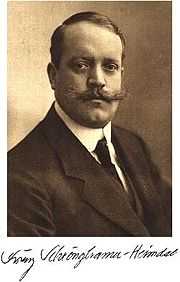Franz Schrönghamer-Heimdal
Franz Schrönghamer-Heimdal (born July 12, 1881 in Marbach Eppenschlag, Lower Bavaria - died 3 September 1962 in Passau), was a Bavarian Catholic writer and painter.
In 1918 his Das kommende Reich (The Coming Reich) appeared, during the November 1918 revolution in Munich. It laid out a blueprint for the 'ecumenical yet distinctly Catholic-oriented spiritual rebuilding of Germany', and he contrasted the purity of Christ, and his true followers, with the perceived immorality of the Jewish-capitalistic spirit. While Schrönghamer made no secret of his Catholic convictions the coming Reich he envisioned was to be interconfessional, both Christian confessions bonded in a "racial community [Volksgemeinschaft] of the same blood, the same law and the same morals", maintained through "race based eugenic measures." He later claimed [ in a 1933 inscription of the book, sent to Nazi party headquarters] that it had influenced the Nazi party advocacy of the principle of Positive Christianity.[2]
Schrönghamer officially joined the Nazi party on 4 February 1920, when it was still known as the Deutsche Arbeiterpartei. He was the party's 222nd member - Hitler, who joined a few months before, had been the 55th. At this time Schrönghamer was "the single most visible figure in the pages of the Völkischer Beobachter, when it served as the unofficial organ of the young völkisch-Nazi movement." Two of Schrönghamer's other writings, Vom Antichrist (late 1918) and Judas, der Weltfeind (mid-1919), both 'flamingly anti-Semitic' were " among the most significant and widely discussed works in Munich at the outset of the Nazi movement. Schrönghamer also exercised a powerful influence over a large number of racist Catholic activists who themselves played important, if subsequently overlooked, roles in the early development and spread of the movement in and around Munich."[3]
